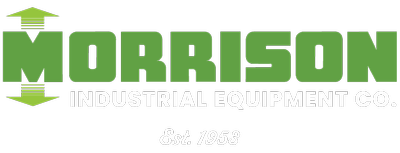Benefits of Walkie Pallet Stackers: Improve Safety & Productivity

Moving and stacking pallets doesn’t always require a ride-on forklift truck. Discover the benefits of using walkie pallet stackers to improve productivity and safety in your warehouse.
Sometimes, a motorized, walk-behind machine is a better solution.
Certainly, if you’re lifting pallets 20’ in the air, going in and out of trailers over an uneven dock for hours each day, or have a 500,000 square foot warehouse, you should use a forklift. However, for tasks in between those big ones, you may be better off using a walkie pallet stacker.
Using walkies for in-between tasks will drive down overall fleet costs because they are less expensive to operate. And, since they’re lighter and slower, they can have the added benefit of improving workplace safety!
What is a Walkie Pallet Stacker?
Similar to a forklift, a walkie pallet stacker is an electric-powered material handling machine designed to lift and transport pallets. The main difference is that a walkie pallet stacker can be powered by electivity and can be walk-behind and manual, making for a great option when maneuvering through small spaces.
Common Types of Motorized Walkie Stackers
The primary distinguishing feature between different walkie stackers is how they distribute their load. The common types include straddle, counterbalanced or fork-over.
Fork-Over Stacker
Fork-Over stackers utilize straddle legs that are located below the forks. Because of this, they are only able to lift bottomless pallets or skids. As compared to the other types of walkie stackers, Fork-Over walkie stackers provide the smallest turning radius.
Straddle Stacker
To allocate load weight, straddle stackers make use of straddle legs. The legs let the walkie stacker straddle a pallet, so the load is contained within the wheelbase which aids the ability to turn in a tighter space. They are usually used for applications like customer zone racking areas, small warehouses and storerooms.
Reach Stacker
Walkie reach stackers are similar to the straddle stacker but are equipped with a Pantograph carriage, which means the carriage is able to maneuver loads forward, away from the stacker’s body. They are most frequently used in applications such as loading trucks, utility vehicles and grocery storerooms.
Counterbalanced Stacker
Counterbalanced walkie stackers use counterbalance weight to allocate loads. This lets them operate without having to worry about the placement of straddle legs. Different from fork-over walkie stackers (with front legs), counterbalanced walkie stackers can lift standard pallets. Due to the counterbalance weight, counterbalanced walkie stackers have the longest total length, which necessitates a bigger turning radius when compared to other types of stackers.
Benefits of Using Walkies in Your Warehouse
Here are some of the advantages walk-behind lift trucks (walkie stackers) offer compared to ride-on forklifts.
Maneuverability
A ride-on forklift may take an eleven- or twelve-foot aisle to make a right-angle turn with a 40” x 48” pallet, but a walkie stacker can typically perform this maneuver in seven or eight feet. Whether navigating around production areas or maximizing storage density for slow-moving goods, the compact turns of a walkie stacker can be a major advantage.
Safety
Ride-on forklifts are a danger to pedestrians. They’re heavy, fast, and can have obstructed sightlines. Walkies are lighter and slower, making them better suited to areas where people are working like production rooms or packing stations.
Productivity
Of all the benefits walk-behind equipment offers, productivity gets overlooked the most. Yes, walkies travel at walking speed, but what about the time that line workers or shipping staff waste waiting for a ride-on vehicle to come and move a load? A lighter, safer, more maneuverable walkie can save time and money.
Maintenance
Walkies weigh about 50% less than ride-on forklifts. Less weight means less shock and vibration to major components over time, and less weight means less work for the drive motor, transmission, and electrical systems. Walkie maintenance costs usually run at half the cost of a similarly rated ride-on lift truck.
Cost-Effective
While most ride-on lift trucks weigh double their rated capacity, walk-behind lift trucks weigh just about half. This fundamental design difference translates into significantly lower costs -- both purchase price and lifetime costs.
Comparison of Electric Forklift vs Motorized Walk-Behind Stacker Pricing
Here’s a simplified comparison of an electric ride-on versus a motorized walk-behind lift truck. Both have a 4,000 lb. capacity.
| Weight | Purchase price | Maintenance | Cost 5yrs / 2500 total hours | |
|---|---|---|---|---|
| Ride-on Forklift | 8,000 lbs. | $30,000 | $1.50/hour | $33,750 |
| Walkie Stacker | 2,200 lbs. | $14,000 | $0.50/hour | $15,250 |
Count on Morrison to Meet Your Industrial Equipment Needs
If you think a walkie stacker is the right solution for your facility, contact us for help choosing the best machine for your application and budget. We have a wide range of options from leading manufacturers and will partner with you to ensure you get the best equipment for your specific needs.
©
